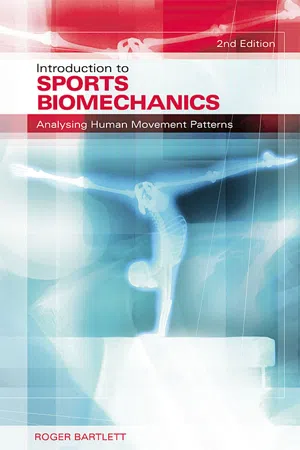
- 320 pages
- English
- ePUB (mobile friendly)
- Available on iOS & Android
About this book
Introduction to Sports Biomechanics provides a genuinely accessible and comprehensive guide to all of the biomechanics topics covered in an undergraduate sports and exercise science degree.
Now revised and in its second edition, Introduction to Sports Biomechanics is full of visual aids to support the text. Every chapter contains cross references to key terms and definitions from that chapter, learning objectives and summaries, study tasks to confirm and extend your understanding, and suggestions to further your reading.
Clearly structured and with many student friendly features, the text covers:
- movement patterns – exploring the essence and purpose of movement analysis
- qualitative analysis of sports movements
- movement patterns and the geometry of motion
- quantitative measurement and analysis of movement
- force and torques– causes of movement
- the human body and the anatomy of movement.
-
This editionis supported by a website containing animation and video clips, and offers sample data tables for comparison and analysis and multiple choice questions to confirm your understanding of the material in each chapter. Introduction to Sports Biomechanics is a must have for students of sport and exercise, human movement sciences, ergonomics, biomechanics, and sports performance and coaching.
Visit the companion website at: www.routledge.com/textbooks/9780415339940.
Frequently asked questions
- Essential is ideal for learners and professionals who enjoy exploring a wide range of subjects. Access the Essential Library with 800,000+ trusted titles and best-sellers across business, personal growth, and the humanities. Includes unlimited reading time and Standard Read Aloud voice.
- Complete: Perfect for advanced learners and researchers needing full, unrestricted access. Unlock 1.4M+ books across hundreds of subjects, including academic and specialized titles. The Complete Plan also includes advanced features like Premium Read Aloud and Research Assistant.
Please note we cannot support devices running on iOS 13 and Android 7 or earlier. Learn more about using the app.
Information
1
Movement patterns – the essence of sports biomechanics
Introduction 1 | ||||
Defining human movements 3 | ||||
Some fundamental movements 8 | ||||
Movement patterns 35 | ||||
Comparison of qualitative and quantitative movement analysis 36 | ||||
Summary 40 | ||||
Study tasks 40 | ||||
Glossary of important terms 41 | ||||
Further reading 42 | ||||
| Knowledge assumed Familiarity with human movement in sport Ability to undertake simple analysis of videos of sports movements |
INTRODUCTION
BOX 1.1 LEARNING OUTCOMES After reading this chapter you should be able to: • think enthusiastically about analysing movement patterns in sport • understand the fundamentals of defining joint movements anatomically • appreciate the differences – and the similarities – between qualitative and quantitative analysis of sports movements • describe, from video observation or pictorial sequences, some simple sport and exercise movements, such as walking, running, jumping and throwing • appreciate why breaking these movements down into phases can help simplify their description and later analysis • be familiar with finding supplementary information – particularly videos – on the book’s website • feel enthusiastic about progressing to Chapters 2 and 3. |
DEFINING HUMAN MOVEMENTS
BOX 1.2 PLANES AND AXES OF MOVEMENT AND POSTURES FROM WHICH MOVEMENTS ARE DEFINED Various terms are used to describe the three mutually perpendicular intersecting planes in which many, although not all, joint movements occur. The common point of intersection of these three planes is most conveniently defined as either the centre of the joint being studied or the centre of mass of the whole human body. In the latter case, the planes are known as cardinal planes – the sagittal, frontal and horizontal planes – as depicted in Figure 1.1 and described below. Movements at the joints of the human musculoskeletal system are mainly rotational and take place about a line perpendicular to the plane in which they occur. This line is known as an axis of rotation. Three axes – the sagittal, frontal and vertical (longitudinal) – can be defined by the intersection of pairs of the planes of movement, as in Figure 1.1. The main movements about these three axes for a particular joint are flexion and extension about the frontal axis, abduction and adduction about the sagittal axis, and medial and lateral (internal and external) rotation about the vertical (longitudinal) axes. • The sagittal plane is a vertical plane passing from the rear (posterior) to the front (anterior), dividing the body into le... |
Table of contents
- Contents
- Figures
- Tables
- Boxes
- Preface
- Introduction
- 1 Movement patterns – the essence of sports biomechanics
- 2 Qualitative analysis of sports movements
- 3 More on movement patterns – the geometry of motion
- 4 Quantitative analysis of movement
- 5 Causes of movement – forces and torques
- 6 The anatomy of human movement
- Index